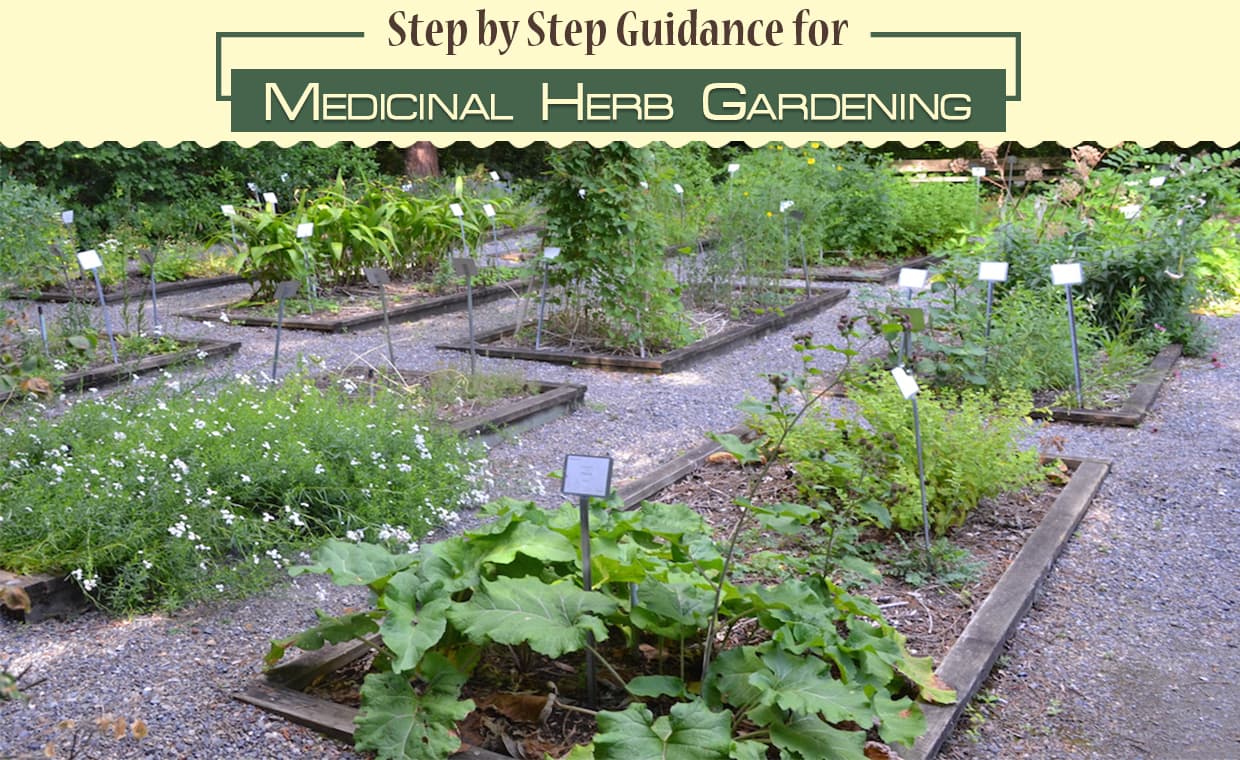
Growing a garden is a fun and advantageous recreation. Though it may seem difficult but it is the fact that growing this does not require a skilled gardener to make them use. In this process, one may make some money and enjoy oneself.
There is a large population that engages in agriculture every year. Yet, some people don’t know much about it. Some people also search for how to do medicinal herb gardening to make good use of their lawn or garden. Nowadays, it has become a trend, but that is great history of medicinal herbs in India.
In one of the Sanskrit shloka, it is said that there is no plant on the earth which cannot be used as a medicine. What is needed it’s know how to use.
India is a rich repository of medicinal herbs plants. In India, the forest is the primary treasure for a large number of medicinal and aromatic plants, which are mostly collected as raw materials for the production of drugs and aroma products. About 8,000 herbal remedies have been classified in AYUSH systems in INDIA. AYUSH is the abbreviation of the medical systems that are being practiced in India such as Ayurveda, Yoga & Naturopathy, Unani, Siddha and Homeopathy.
According to ‘National Health Portal India’, recently, WHO (World Health Organization) estimated that 80 % of people over the globe, rely on herbal medicines for one or other aspect of their primary health care needs and according to WHO, approximately 21,000 plant species have the potential for being used as medicinal plants.
Medicinal plant includes various types of plants used in herbalism – herbology or herbal medicines. The word herb came from the Latin word, ‘herba’ and an old French word ‘herbe’. Herbs are plants that have nutritive properties and some of them have medicinal properties too. Plants like mint, basil, lemon balm, etc. are called medicinal herbs plants because they can be used to cure diseases and provide relief.
A Medicinal Herb Garden is defined as a garden planted to serve the requirements of people’s health maintenance, as well as the acute health issues which might occur. It is easy to grow and can be used in home cooking, health and beauty treatment.
Step by Step Guidance for Medicinal Herb Gardening
It is important to have a clear idea about the requirements of the plants before starting the process of planting. For making this procedure easy, we have mentioned a particular method along with some tips and tricks to make your gardening easy.
01. Decide the Place and Plants
The first step for the medicinal herb gardening is to decide the area you will be planting your herbs. You can either choose to go for the small pots in the lawn or select an area of your garden to grow medicinal herbs. Make sure that the area in the lawn you are selecting, gets adequate sunlight during the day so that the plants can grow without any issues.
Once you decided the way you want to plant the herbs, study about the soil of your medicinal garden or lawn. Generally, herbs can grow well with borderline fertile soil, but a little research will be helpful to you in a longer run. Considering the soil, the region’s climate and other factors decide about the herbs that you want to grow.
You can also consult a local gardener to get information about which plants grow better in your garden or lawn’s environment. If you are a beginner, then it is better to opt for herbs like yarrow, violets, peppermint, echinacea, chamomile, etc. as these are easy to maintain and needs only six hours of sunlight.
02. Get the Seeds or Seedlings
The next step is to decide if you want seeds or seedlings for your plant. You can easily get good quality medicinal herb seeds online or from the local nursery. Make sure to know all the information about the seeds before planting them. You can also contact your local gardener or nursery owner to know the best place to get excellent quality of seeds or saplings.
03. Plant the Medicinal Herbs
Once you have collected all the information and seeds, you are ready to plant your medicinal herb garden. If you are planting invasive species of herbs such as peppermint or yarrow, it is advisable to plant them in the pots. The rest of the species can be planted directly in the lawn. Before planting the seeds, make sure that the soil is well-drained and suitable for the plant. Also, place the plants where they can get the maximum sunlight.
Go through all the directions mentioned on the seed packets thoroughly and provide the optimal environment for plants to grow.
04. Water the Herbs
It is vital to keep the soil around the plant moist initially. Start watering the plants as per the directions mentioned on the packets once it begins to grow. Also, be careful while you are watering the plants, as herbs need a little amount of water comparatively. You can also research about the requirements of the herb species which you are planting.
05. Harvest the Plants

Many herbs can be harvested once or twice in the season. Check the harvesting time of the species that you are planting in your garden. Some herbs can be harvested continuously depending upon the season they grow in, the climate of the region, and other factors.
Benefits of Medicinal Herb Plants
There are numerous befits of medicinal herb plants such as,
01. A lot of pharmaceutical companies all over the world, use herbs in the preparation of drugs.
02. Apart from this, herbs have been used in ancient medicinal practices such as Ayurveda and Unani.
03. One can plant medicinal herbs that are beneficial in boosting immunity and also helps in curing diseases.
04. Some herbs like black pepper, cinnamon etc. are used to heal wounds, boils and sores.
05. They are easy to grow, aesthetic, amazing in taste and aroma, and many of them greatly attract the bees and the butterflies.
06. Many herbs are used as blood purifiers, to alter or change a long-standing condition by reducing the metabolic toxins.
07. Some herbs such as aloe, sandalwood, turmeric etc. are very high in their medicinal values and normally used as antiseptic.
Common Medicinal Herb Plants
To help you to choose the plants, here is a list of the herbs that you can plant, are given below:
01. Echinacea
This herb has the least side effects and is also completely safe for people of various ages. The herb aids in fighting the common cold, respiratory problems and also helps in increasing immunity. However, the herb can be allergic to some people and is also tough on the stomach.
02. Lavender
This one is my favourite herb. It adds not only a beautiful lilac colour to your garden but also has many benefits. The people struggling with stress and anxiety can use lavender oil. The herb also has sedative properties that can be effective for people struggling with sleep. It is not recommended to use it undiluted as it can irritate the skin.
03. Chamomile
Chamomile flavour is gaining popularity when it comes to flavoured tea. You can cultivate this plant in your garden and enjoy the flavour yourself. It also has anti-anxiety properties and can also help people with insomnia.
04. Cayenne Pepper
This herb is an excellent choice if you are a fan of a spicy kick, it adds to the sauces or dips. Cayenne pepper aids in boosting metabolism and also detoxifies the body. It also aids in improving blood circulation and reducing pain.
05. Rosemary
A popular ingredient in many dishes can also be grown in your garden. Rosemary helps in enhancing brain functions and also improves memory. It is also useful in decreasing inflammation and improving blood circulation. You can also add the dried leaves of rosemary to the tea or the meals you prepare.
06. Calendula
It is used as a soothing skin wash, tea and salves. It is often an ingredient in baby- related skincare items. They are edible and make a vibrant addition to a salad as well. Its flowers reseed themselves.
07. Aloe Vera
It is used as skincare for rashes, sunburn, eczema etc. Its flower grow on a spiky stalk up to three feet long.
08. Lemon Balm
Traditionally, Lemon Balm has been used to lower fevers and treat colds by stimulating sweating, calm the digestive tract and conquer insomnia.
Final thoughts, medicinal herb gardening is easy if the proper protocol is followed. If you are reluctant to do the entire process by yourself, seek help from the people in your neighbourhood having such gardens. Invest a good time in researching and knowing everything about the herbs which you are planning to plant in your garden. Be sure to think about sun, soil- type, temperature and precipitation. Once the herbs are harvested, some of them are required to dry before its use. Store the dried herbs in places away from the direct sunlight. And voila, you have dried herbs in your pantry grown in your own garden. Herbs have many values but a few of the most common uses include aromatherapy, medicinal, as seasonings and flavourings in foods & beverages, and in salads. Many herbs are chockfull of cancer-fighting antioxidants, valuable nutrients, fat-free flavour and more. It’s more affordable than conventional medicine. It is a natural healing medicine, easier in getting than prescribed medicine. It also strengthens immunity and has no side effects. It costs minimal, stabilizes hormones and metabolism.
Reviewing the present scenario and the vast benefits of the medicinal herbs, the gardening of such type of herbs is essential as they have better culture acceptability, better compatibility and adaptability with the human body and pose lesser side effects.
Also Read:
How to Grow Five Organic Vegetables on Your Terrace?
Everything You Need to Know About Pot or Container Gardening
How Expanded Clay Aggregate Helps in Gardening?
Image Courtesy: Image 1 – sustainability, Image 3


































